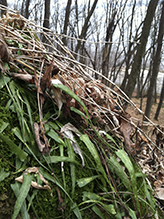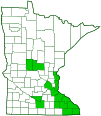walking fern
(Asplenium rhizophyllum)
Conservation • Description • Habitat • Ecology • Use • Distribution • Taxonomy
Conservation Status |
|
|||||||
| IUCN Red List | not listed |
|||||||
| NatureServe | N5 - Secure SNR - Unranked |
|||||||
| Minnesota | not listed |
|||||||
Description |
||
Walking fern is a small, attractive, easily identified fern. It occurs in North America from Quebec to Florida west to Manitoba and Arkansas. It reaches the western extent of its range in Minnesota, where it occurs in the Driftless Area in the southeast, north to the Metro Area, with scattered occurrences in Todd, Morrison, Nicollet, and Blue Earth Counties. It is also cultivated. Its unique appearance makes it one of the most easily recognized ferns in Minnesota. It is found on moss-covered cliff faces and crevices of rock outcroppings where it is protected from the wind. It grows in moist, humid conditions on thin, rocky, limey (calcareous) soil under dense or partial shade. It sometimes grows on fallen logs or on soil. It rarely grows on sandstone. Walking fern is low growing, 1″ to 6″ in height, perennial fern that rises on a tuft of leaves from the crown of a short, slender, erect, underground stem (rhizome) and slender, fibrous roots. The leaf stalk, variously called the stipe or the petiole, is slender, flattened, and grooved above. It is reddish-brown and sometimes shiny at the base, becoming dull and green near the top. It can vary greatly in length, from 3⁄16″ (0.5 cm) long and 0.1 times as long as the blade, to 4¾″ (12 cm) long and 1.5 times longer than the blade. There are dark brown, narrowly triangular scales at the base and minute, club-shaped hairs near the top. The blade varies greatly in size and shape, even on the same plant. It is leathery, undivided, narrowly triangular to linear lance-shaped, ⅜″ to 11¾″ (1 to 30 cm) long, and 3⁄16″ to 2″ (0.5 to 5.0 cm) wide. The base of the blade may be heart-shaped (cordate), arrowhead-shaped with the lobes turned outward (hastate), or have ear-like lobes (auriculate). The tip may be rounded or very long and thin. When long and thin the leaf will root at the tip when it touches the ground, giving rise to a new plant. This is the feature that gives the fern its common name. The upper surface is dark green and hairless. The lower surface is pale green and hairless or sparsely hairy. The margins may be flat or slightly wavy. The lateral veins branch and rejoin before reaching the margin, forming an intertwining network with well-defined open areas near the midrib. Sterile leaves are similar in shape but smaller in size than fertile leaves. The reproductive structures are born on the underside of the blade. There are numerous elongated clusters (sora) of spore-bearing cases (sporangia) scattered irregularly along the lateral veins on each side of the midrib. The flap of tissue covering each sorus (indusium) is inconspicuous and is attached to one side. There are 64 spores in each sporangium. |
||
Height |
||
1″ to 6″ |
||
Similar Species |
||
| No similar species in North America | ||
Habitat |
||
Moist. Moss covered cliff faces and rock outcroppings. Full shade. Thin, rocky, calcareous soil. |
||
Ecology |
||
Sporulation |
||
May to October |
||
Pests and Diseases |
||
|
||
Use |
||
|
||
Distribution |
||||
|
Sources |
|||
| 12/21/2020 | ||||
Nativity |
||||
Native |
||||
Occurrence |
||||
Somewhat rare and local |
||||
Taxonomy |
|||
| Kingdom | Plantae (Plants) | ||
| Division | Tracheophyta (Vascular Plants) | ||
| Subdivision | Polypodiophytina | ||
| Class | Polypodiopsida (ferns) | ||
| Subclass | Polypodiidae | ||
Order |
Polypodiales (true ferns) | ||
Suborder |
Aspleniinae (eupolypods II) | ||
Family |
Aspleniaceae (spleenworts) | ||
Genus |
Asplenium (spleenworts) | ||
Until recently, walking fern was classified as Camptosorus rhizophyllus. It was originally described by Carl Linnaeus in 1753 as Asplenium rhizophyllum. In 1833 it was placed in a segregated genus Camptosorus due to the irregular arrangement ofr its sori. DNA studies published in 1999 and 2004 showed that the genus Camptosorus is nested within Asplenium, and the species’ original classification was restored. |
|||
Subordinate Taxa |
|||
|
|||
Synonyms |
|||
Antigramma rhizophylla Camptosorus rhizophyllus |
|||
Common Names |
|||
North American walking fern walking fern |
|||
Glossary
Calcareous
Alkaline; rich in limestone; containing a high proportion of calcium carbonate.
Indusium
Undergarment. In ferns: A veil covering the cluster (sorus) of spore-producing structures (sporangia). In fungi: A skirt-like structure hanging from the cap (receptacle) of a stinkhorn.
Rhizome
A horizontal, usually underground stem. It serves as a reproductive structure, producing roots below and shoots above at the nodes.
Sorus
A compact cluster of spore-bearing cases or sacs (sporangia) on a fern. Plural: sori.
Sporangium
A spore bearing structure, as of a fern, moss, or slime mold. Plural: sporangia.
Stipe
A supporting stalk-like structure lacking vascular tissue. In fungi, the stalk supporting the mushroom cap. In ferns, the stalk connecting the blade to the rhizome. In flowering plants, the stalk connecting the flower’s ovary to the receptacle. Iin orchids; the band connecting the pollina with the viscidium.
Visitor Photos |
|||||
Share your photo of this plant. |
|||||
| This button not working for you? Simply email us at info@MinnesotaSeasons.com. Attach one or more photos and, if you like, a caption. |
|||||
Nancy Falkum |
|||||
Walking fern Asplenium rhizophyllum |
|||||
 |
|||||
Walking fern Asplenium rhizophyllum looking down the hill to the frozen Mississippi River visible through the trees taken 8 December 2015 |
 |
||||
MinnesotaSeasons.com Photos |
|||||
|
|||||

Slideshows |
||

Visitor Videos |
|||
Share your video of this plant. |
|||
| This button not working for you? Simply email us at info@MinnesotaSeasons.com. Attach a video, a YouTube link, or a cloud storage link. |
|||
Other Videos |
|||
| Walking Fern (Asplenium rhizophyllum) Andrew McCaskill |
|||
About
Sep 30, 2021 This page will serve as a repository for field botany videos, primarily for my biology students, though all are welcome. I will periodically post field botany videos as opportunity avails itself. Field botany, of course, is better “in the field.” However, I have found it difficult to take my students into “the field” for various reasons. Limitations aside, I desire to transmit my love for botany to my students and hope in some small measure to introduce them to the wonderful world of field botany. Perhaps, as it did in me, this effort will spark a future love for botany and more importantly, a love for the Creator of these incredible botanical wonders. My purpose then is to… (1) Introduce my students to native plants of Virginia (though occasionally plants from other regions might make the list). (2) Provide a snapshot of the plant only (a teaser of sorts). My intent is not to be thorough, since I desire for students to complete a field botany notebook and fill in the missing details themselves. (3) Give God the due glory He deserves for His creative genius. |
|||
| Exploring Limestone Cliffs For Unique Ferns & Other Plants Learn Your Land |
|||
About
Jan 30, 2017 Limestone is a unique substrate housing unique plant communities. In this video, I explore limestone cliffs in Western Pennsylvania in search of unique ferns and other plants — including walking fern (Asplenium rhizophyllum), marginal wood fern (Dryopteris marginalis), sharp-lobed hepatica (Anemone acutiloba), and partridge berry (Mitchella repens). Music: Doctor Turtle — "Lullaby For Democracy" https://creativecommons.org/licenses/by-nc/4.0/ Follow Adam Haritan online here: |
|||

Visitor Sightings |
|||||
Report a sighting of this plant. |
|||||
| This button not working for you? Simply email us at info@MinnesotaSeasons.com. Be sure to include a location. |
|||||
| Nancy Falkum 12/8/2015 |
Location: Bald Eagle Bluff SNA Walking fern Asplenium rhizophyllum |
||||
MinnesotaSeasons.com Sightings |
|||||

Created: 12/21/2021
Last Updated:

